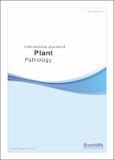| dc.contributor.author | Aloyce, Agatha | |
| dc.contributor.author | Mbega, Ernest | |
| dc.date.accessioned | 2024-02-16T11:38:09Z | |
| dc.date.available | 2024-02-16T11:38:09Z | |
| dc.date.issued | 2023 | |
| dc.identifier.uri | https://scialert.net/abstract/?doi=ijpp.2023.21.28 | |
| dc.identifier.uri | https://dspace.nm-aist.ac.tz/handle/20.500.12479/2465 | |
| dc.description | A research article was published by International Journal of Plant Pathology Year: 2023 | Volume: 14 | en_US |
| dc.description.abstract | Background and Objective: Ralstonia solanacearum (Smith) is one of the most destructive bacterial plant pathogens in the world. It causes bacterial wilt disease (BWD) in several plant species including tomato. This research was carried out to understand the diversity of the causing bacterial isolates and develop management strategies based on the characteristics of the prevailing pathogens in Tanzania. Materials and Methods: Forty isolates were collected from the infected tomato plants preserved in the laboratory from the BWD field survey in 2018 in Tanzania. Isolates were grown on TTC medium and DNA was extracted from a single colony of each isolate using the bacterial DNA extraction kit for molecular analysis using PCR. The similarity coefficients were predicted by the Dice technique for all possible isolate pairs based on the fingerprint groups. Finally, the aligned sequences were contrasted with the standard strains in the National Center for Biotechnology Information (NCBI) database to determine resemblance using the Basic Local Alignment Tool (BLAST). Results: According to the results of the phylogenetic analysis, 80% of the samples belonged to phylotypes I and III of the R. pseudosolanacearum and 20% to phylotype II of the R. solanacearum genospecies, respectively. Findings have shown that Tanzania has a diversified population of the Ralstonia solanacearum species complex that causes tomato BWD. Two species and three phylotypes of infections that cause tomato BWD were found to predominate in various agro-ecological zones across the nation. Phylotypes I and III of Ralstonia pseudosolanacearum and phylotype II of Ralstonia solanacearum were the isolates that were found. Conclusion: Strong standard phytosanitary measures must be implemented worldwide by plant health authorities as a result of the first report of phylotype II of RSSC in Tanzania.Background and Objective: Ralstonia solanacearum (Smith) is one of the most destructive bacterial plant pathogens in the world. It causes bacterial wilt disease (BWD) in several plant species including tomato. This research was carried out to understand the diversity of the causing bacterial isolates and develop management strategies based on the characteristics of the prevailing pathogens in Tanzania. Materials and Methods: Forty isolates were collected from the infected tomato plants preserved in the laboratory from the BWD field survey in 2018 in Tanzania. Isolates were grown on TTC medium and DNA was extracted from a single colony of each isolate using the bacterial DNA extraction kit for molecular analysis using PCR. The similarity coefficients were predicted by the Dice technique for all possible isolate pairs based on the fingerprint groups. Finally, the aligned sequences were contrasted with the standard strains in the National Center for Biotechnology Information (NCBI) database to determine resemblance using the Basic Local Alignment Tool (BLAST). Results: According to the results of the phylogenetic analysis, 80% of the samples belonged to phylotypes I and III of the R. pseudosolanacearum and 20% to phylotype II of the R. solanacearum genospecies, respectively. Findings have shown that Tanzania has a diversified population of the Ralstonia solanacearum species complex that causes tomato BWD. Two species and three phylotypes of infections that cause tomato BWD were found to predominate in various agro-ecological zones across the nation. Phylotypes I and III of Ralstonia pseudosolanacearum and phylotype II of Ralstonia solanacearum were the isolates that were found. Conclusion: Strong standard phytosanitary measures must be implemented worldwide by plant health authorities as a result of the first report of phylotype II of RSSC in Tanzania. | en_US |
| dc.language.iso | en | en_US |
| dc.publisher | Knowledgia Scientific | en_US |
| dc.subject | BLAST | en_US |
| dc.subject | bactericides | en_US |
| dc.subject | phylotypes | en_US |
| dc.subject | geno-species | en_US |
| dc.subject | Ralstonia solanacearum species complex | en_US |
| dc.subject | tomato | en_US |
| dc.title | Diversity of Ralstonia solanacearum Causing Tomato Bacterial Wilt Disease in Tanzania | en_US |
| dc.type | Article | en_US |

